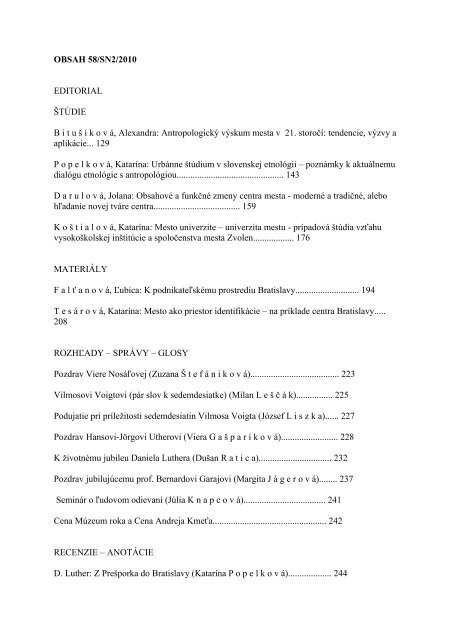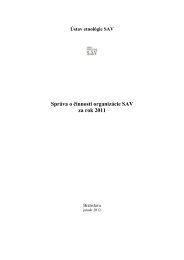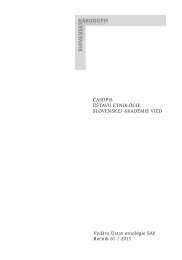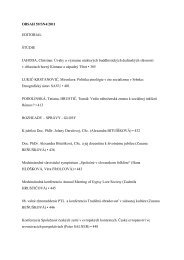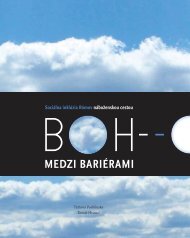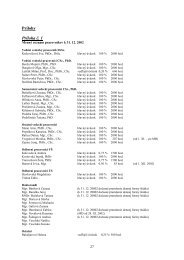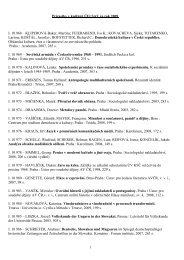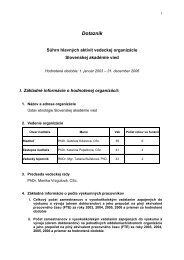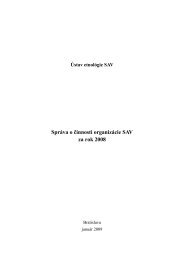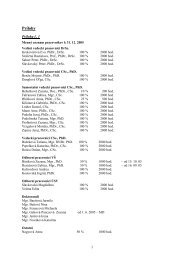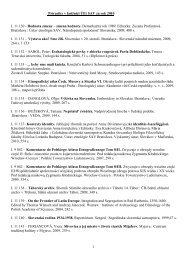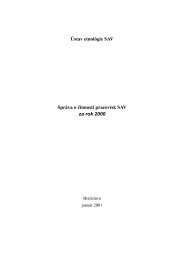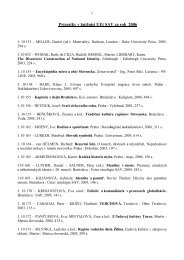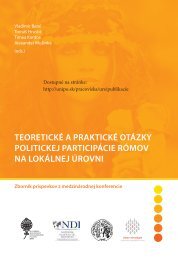OBSAH 58/SN2/2010 EDITORIAL Å TÃDIE B itu Å¡ à kov á, Alexandra
OBSAH 58/SN2/2010 EDITORIAL Å TÃDIE B itu Å¡ à kov á, Alexandra
OBSAH 58/SN2/2010 EDITORIAL Å TÃDIE B itu Å¡ à kov á, Alexandra
Create successful ePaper yourself
Turn your PDF publications into a flip-book with our unique Google optimized e-Paper software.
<strong>OBSAH</strong> <strong>58</strong>/<strong>SN2</strong>/<strong>2010</strong><br />
<strong>EDITORIAL</strong><br />
ŠTÚDIE<br />
B i t u š í k o v á, <strong>Alexandra</strong>: Antropologický výskum mesta v 21. storočí: tendencie, výzvy a<br />
aplikácie... 129<br />
P o p e l k o v á, Katarína: Urbánne štúdium v slovenskej etnológii – poznámky k aktuálnemu<br />
dialógu etnológie s antropológiou............................................... 143<br />
D a r u l o v á, Jolana: Obsahové a funkčné zmeny centra mesta - moderné a tradičné, alebo<br />
hľadanie novej tváre centra...................................... 159<br />
K o š t i a l o v á, Katarína: Mesto univerzite – univerzita mestu - prípadová štúdia vzťahu<br />
vysokoškolskej inštitúcie a spoločenstva mesta Zvolen.................. 176<br />
MATERIÁLY<br />
F a l ť a n o v á, Ľubica: K podnikateľskému prostrediu Bratislavy............................ 194<br />
T e s á r o v á, Katarína: Mesto ako priestor identifikácie – na príklade centra Bratislavy.....<br />
208<br />
ROZHĽADY – SPRÁVY – GLOSY<br />
Pozdrav Viere Nosáľovej (Zuzana Š t e f á n i k o v á)....................................... 223<br />
Vilmosovi Voigtovi (pár slov k sedemdesiatke) (Milan L e š č á k)................ 225<br />
Podujatie pri príležitosti sedemdesiatin Vilmosa Voigta (József L i s z k a)...... 227<br />
Pozdrav Hansovi-Jörgovi Utherovi (Viera G a š p a r í k o v á)......................... 228<br />
K životnému jubileu Daniela Luthera (Dušan R a t i c a)................................ 232<br />
Pozdrav jubilujúcemu prof. Bernardovi Garajovi (Margita J á g e r o v á)........ 237<br />
Seminár o ľudovom odievaní (Júlia K n a p c o v á).................................... 241<br />
Cena Múzeum roka a Cena Andreja Kmeťa.................................................. 242<br />
RECENZIE – ANOTÁCIE<br />
D. Luther: Z Prešporka do Bratislavy (Katarína P o p e l k o v á)................... 244
M. Detelić: Epski gradovi. Leksikon (Jana P o s p í š i l o v á)...................... 246<br />
P. Frankl – P. Frankl: Židia v Žiline (Peter S a l n e r)............................................ 247<br />
K. Altman – L. Kuděl<strong>kov</strong>á – V. Filip: Zmizelý svět brněnských kaváren<br />
(Peter S a l n e r).................................. 249<br />
M. Ferencová – J. Nos<strong>kov</strong>á (eds.): Paměť města (obraz města, veřejné<br />
komemorace a historické zlomy v 19. – 21. století) (Peter S a l n e r)........... 250<br />
B. Soukupová – H. Novotná – Z. Jur<strong>kov</strong>á – A. Stawarz (eds): Evropské město (Identita,<br />
symbol, mýtus) (Peter S a l n e r)..................... 251<br />
Journal of Urban Ethnology (Ľubica F a l ť a n o v á)............................................ 253<br />
B. Malovcová a kol.: SVIT (1934 - 2009) - História jednej myšlienky (Peter L a u č<br />
ík)............................................ 254<br />
J. Fekete-Apolkin: Slovník modrokamenských toponým (Miloš Š í p k a).......... 256<br />
M. Šrám<strong>kov</strong>á: Česká prozaická folkloristika v letech 1945–2000 (Viera G a š p a r í k o v<br />
á)............................ 257<br />
P. Slav<strong>kov</strong>ský: Svet na odchode. Tradičná agrárna kultúra Slová<strong>kov</strong> v strednej a južnej<br />
Európe (Miroslav V á l k a)...... 259<br />
CONTENTS<br />
STUDIES<br />
B i t u š í k o v á, <strong>Alexandra</strong>: Anthropological Research of the Town in the 21st Century:<br />
Trends, Challenges and Applications...................................... 129<br />
P o p e l k o v á, Katarína: Urban Research in Slovak Ethnology: Notes to Current Dialog<br />
between Ethnology and Anthropology... 143<br />
D a r u l o v á, Jolana: Contents and Functional Changes of the City Centre................. 159<br />
K o š t i a l o v á, Katarína: The Town to the University - The University to the Town.... 176<br />
MATERIALS<br />
F a l ť a n o v á, Ľubica: On the Enterprise Environment in Bratislava........................ 194<br />
T e s á r o v á, Katarína: The Town as a Place of Identification – with the Example of<br />
Bratislava City Centre.............................. 208
NEWS<br />
Greetings to Viera Nosáľová (Zuzana Š t e f á n i k o v á)............................................ 223<br />
To Vilmos Voigt (a few words for his 70th) (Milan L e š č á k)................................... 225<br />
An Event for the Occasion of Vilmos Voigt‘s Seventieth Birthday (József L i s z k a)..... 227<br />
Greetings to Hans-Jörg Uther (Viera G a š p a r í k o v á)............................................. 228<br />
For Daniel Luther‘s Life Jubilee (Dušan R a t i c a)............................................... 232<br />
Greetings to Prof. Bernard Garaj on his Jubilee (Margita J á g e r o v á)............... 237<br />
Seminar on Folk Dress (Júlia K n a p c o v á) ………………………………….241<br />
Museum of the Year Prize and Andrej Kmeť Prize..................................................... 242<br />
BOOK REVIEWS- ANNOTATIONS<br />
A B S T R A C T S SN 2/<strong>2010</strong><br />
ANTHROPOLOGICAL RESEARCH OF THE TOWN IN THE 21st CENTURY:<br />
TRENDS, CHALLENGES AND APPLICATIONS<br />
(ANTROPOLOGICKÝ VÝSKUM MESTA V 21. STOROČÍ: TENDENCIE, VÝZVY A<br />
APLIKÁCIE)<br />
ALEXANDRA BITUŠÍKOVÁ<br />
PhDr. <strong>Alexandra</strong> B<strong>itu</strong>ší<strong>kov</strong>á, CSc., Ústav vedy a výskumu, Univerzita<br />
Mateja Bela, Cesta na amfiteáter 1, 97401 Banská Bystrica, Slovakia,<br />
alexandra.b<strong>itu</strong>si<strong>kov</strong>a@umb.sk<br />
The paper deals with trends, challenges and applications of urban<br />
anthropology worldwide. It brings a comparative view of historical<br />
developments and of contemporary theoretical, methodological and<br />
thematic schools, directions and tendencies in the development of<br />
urban anthropology. The author presents her subjective reflections<br />
on older and recent literature, and identifies three areas of urbananthropological<br />
research of the present day: city and people; city and<br />
space; and city and culture. In addition to theoretical contributions
of urban anthropology to multidisciplinary urban studies, she<br />
emphasises also the importance of applied anthropological<br />
research in urban place-making and governance. On the basis<br />
of global trends in urban anthropological studies, she suggests<br />
their implications on the Slovak urban anthropological research.<br />
Kľúčové slová: urbánna antropológia, história a vývojové trendy,<br />
metodológia, apli<strong>kov</strong>aný urbánny výskum<br />
Key words: urban anthropology, history and development trends,<br />
methodology, applied urban research<br />
URBAN RESEARCH IN SLOVAK ETHNOLOGY: NOTES TO CURRENT DIALOG<br />
BETWEEN ETHNOLOGY AND ANTHROPOLOGY<br />
(URBÁNNE ŠTÚDIUM V SLOVENSKEJ ETNOLÓGII – POZNÁMKY<br />
K AKTUÁLNEMU DIALÓGU ETNOLÓGIE S ANTROPOLÓGIOU)<br />
KATARÍNA POPELKOVÁ<br />
PhDr. Katarína Popel<strong>kov</strong>á, CSc., Ústav etnológie SAV, Klemensova<br />
19, 813 64 Bratislava – Slovensko; e-mail: katarina.popel<strong>kov</strong>a@savba.sk<br />
This study is concerned with the contemporary trends of development<br />
in urban research in Slovak ethnology which have been evolving since<br />
the 1980s. The author summarises the findings on this orientation in<br />
the course of the last decade and, based on their analysis, identifies<br />
the main thematic trends, comments on their content and indicates<br />
the methodological connections of the current dialogue of Slovak<br />
ethnology and the urban research developing within its framework.<br />
As its broader context the study employs the currently ongoing<br />
communication of Slovak ethnology and social/cultural anthropology<br />
as two distinct disciplines.<br />
As analysis shows, urban ethnology in Slovakia has developed in<br />
three different directions in the period under review. (1) In the form<br />
of a broad current of themes and approaches it continued the research<br />
and interpretative trends which set in during the 1980s and especially<br />
during the 1990s. (2) The second developmental trend which is<br />
postulated is a successful attempt to integrate the research results of<br />
Slovak ethnologists into a European context of examination of the<br />
processes of diversity in towns, on the basis of participation in the<br />
Network of Excellence Project entitled Sustainable Development in<br />
a Diverse World. Communication with the theoretical premises of<br />
urban researches by the European social sciences (anthropology,
sociology, demography and so forth) has provided Slovak researchers<br />
with an opportunity to gain new thematic and methodological stimuli<br />
which have been utilised abroad for study of the town.<br />
(3) A third direction of development in urban research is identified<br />
by the author as the research and especially the theoretical activity<br />
of the youngest generation of academic Slovak ethnologists, who in<br />
working with the empirical material gained from research of Slovak<br />
towns have declared anthropological premises and knowledge goals.
Although they are not consciously developing their work in the context<br />
of urban ethnology, on closer inspection it is apparent that they have an<br />
opportunity to influence its further thematic and theoretical orientation.<br />
Their work offers a critical evaluation and use of theories from a<br />
number of social and human sciences; they point to the inescapable<br />
need to cultivate terminological discipline and reject the intuitive<br />
employment of theoretical concepts.<br />
Kľúčové slová: etnológia v meste, slovenská etnológia, urbánna<br />
etnológia, dejiny etnológie<br />
Key words: ethnology in the town, Slovak ethnology, urban ethnology,<br />
history of ethnology<br />
CONTENTS AND FUNCTIONAL CHANGES OF THE CITY CENTRE<br />
(<strong>OBSAH</strong>OVÉ A FUNKČNÉ ZMENY CENTRA MESTA - Moderné a tradičné, alebo<br />
hľadanie novej tváre centra mesta)<br />
JOLANA DARULOVÁ<br />
Doc. PhDr. Jolana Darulová, CSc., Ústav vedy a výskumu UMB, Cesta<br />
na amfiteáter 1, 974 01 Banská Bystrica, Slovensko;<br />
jolana.darulova@umb.sk<br />
Since 1889 the central areas of Slovak towns have undergone striking<br />
changes in content and function. One may rate positively the exclusion<br />
of traffic and the introduction of pedestrian zones where the commercial<br />
and social-cultural potential of the town is normally concentrated. This<br />
has created opportunities for meeting, casual trade and social contacts.<br />
Based on research into the changes of content and function in the<br />
centre of Banská Bystrica, one may say that the historic memory of<br />
the town has come into confrontation with the new contents, meanings<br />
and symbols immediately present in the town‘s central areas. The<br />
nodes of communication are gradually changing in the process of<br />
transformation, while at the same time modernisation fills with new<br />
contents above all those „vacated places“ which were distinctively<br />
marked by socialism in the recent past. Freedom of enterprise, free<br />
trade and the market mechanism have permitted new elements and<br />
processes to penetrate to the town spaces, visible in the ethnicity of<br />
shopkeepers and business executives as well as in the massive inrush<br />
of hypermarkets and shopping centres. A positive phenomenon is the<br />
fact that in the process of rebuilding the square and its adjoining streets
the original historic character of the town centre has been preserved<br />
and courtyards have been opened up and made accessible to the public,<br />
with suitable building extensions for small shops and enterprises.<br />
However, the construction of a commercial-social centre s<strong>itu</strong>ated in<br />
the vicinity of the pedestrian zone has disrupted many of the square‘s<br />
functions and much commercial and social activity has transferred<br />
itself to this new complex.<br />
Kľúčové slová: urbánna etnológia, mesto Banská Bystrica, urbanizácia,<br />
industrializácia, deindustrializácia, výstavba nákupno-spoločenského<br />
centra
Key words: urban ethnology, city Banská Bystrica, urbanization,<br />
industrialization, deindustrialization, construction of a commercialsocial<br />
centre<br />
THE TOWN TO THE UNIVERSITY – THE UNIVERSITY TO THE TOWN<br />
(MESTO UNIVERZITE – UNIVERZITA MESTU - prípadová štúdia vzťahu vysokoškolskej<br />
inštitúcie a spoločenstva mesta Zvolen)<br />
KATARÍNA KOŠTIALOVÁ<br />
PhDr. Katarína Koštialová, PhD., Ústav vedy a výskumu UMB, Cesta na<br />
amfiteáter 1, 974 01 Banská Bystrica, Slovensko;<br />
katarina.kostialova@umb.sk<br />
This paper is concerned with researching the existence of a university<br />
and its influence on a small town. The object of investigation was<br />
the Technical University (formerly the University of Forestry and<br />
Woodworking) and the town of Zvolen. The author studied where,<br />
how, and by means of what and whom the university was presented<br />
in the town and perceived by the town‘s inhabitants. She investigated<br />
the university in the broader context of the town, with emphasis on the<br />
university-town interaction.<br />
The author focused on the „inner“ and especially the „outer“ life of the<br />
university, its cultural, economic, social capital and their presentation.<br />
In this paper the university is perceived as an inst<strong>itu</strong>tion which apart<br />
from its inductive-educational, scientific-research and cultural-social<br />
functions also fulfils a function of cultural reproduction. Simultaneously<br />
it is a bearer of socio-cultural values and traditions, status rankings,<br />
and the most varied bonds, communicative relations and meanings.<br />
The paper also points to the reasons for the emergence, preconditions,<br />
formation and establishment of the university in the town, which are<br />
reflected not only in the town‘s socio-spatial structure but also in<br />
the cultural capital of its inhabitants (for example, the educational<br />
structure). The existence of a school whose orientation is unique and<br />
specific in Slovakia is mirrored also in the construction of a network<br />
of scientific-research workplaces in the town in question, which is<br />
regarded as the centre of forestry and woodworking. Currently there is<br />
no other town in Slovakia where one can find so many forestry research<br />
and teaching establishments of state-wide relevance.<br />
Contacts and social networks of the town‘s inhabitants with the
university are constructed also through the medium of the TU‘s<br />
employees, who are themselves mainly Zvolen people, and by a
dynamic group of students. An important indicator also is the economic<br />
capital which the university represents in a small town. It is expressed in<br />
employment opportunities and in the form of other material resources.<br />
The author states that the university students form a social group<br />
which contributes to creating urban subcultures and in their r<strong>itu</strong>als<br />
display a consciousness of common culture and identity and the<br />
continuity of forestry traditions in this area. The existence of the<br />
university also brings the town‘s inhabitants a specific culturalsocial<br />
and educational dimension which is, as regards the school‘s<br />
orientation, different from other towns. The activities which the<br />
school and the students carry out (erecting maypoles, the folk<br />
festival, lectures, exhibitions and sporting activities) are not practised<br />
exclusively on the university grounds but are rather part of the urban<br />
space, and the town‘s inhabitants take part in them deliberately or<br />
casually. The urban society views them positively, as characteristic<br />
and typical of the town of Zvolen, which is identified with them.<br />
Kľúčové slová: mesto Zvolen, Technická univerzita Zvolen, študenti<br />
univerzity, interakcia, r<strong>itu</strong>ály<br />
Key words: city Zvolen, Technical University of city Zvolen, students<br />
of the univercity, interaction, r<strong>itu</strong>als


